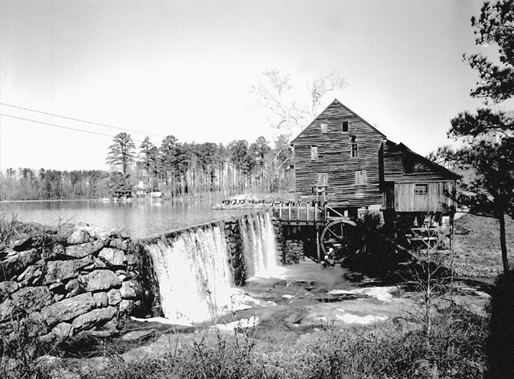Gristmills
Gristmills used to grind corn, wheat, and other grains into flour and meal were a common sight in eighteenth- and nineteenth-century North Carolina. The first recorded North American gristmill was built in Jamestown, Va., in 1621. As settlers moved from the Jamestown area into what is now northeastern North Carolina, they carried their milling techniques with them and began building small mills to grind grain.

Gristmills generally operated by guiding a stream of water into a waterwheel, which provided the power to rotate the series of huge millstones that crushed the grain into progressively smaller pieces. Most early North Carolina gristmills were situated along creeks for a source of waterpower, usually near natural falls. Many gristmills had saws attached, harnessing the waterpower not only to grind flour but also to saw lumber. Power was increased by building dams. On some mills, millraces were built to carry water to the mill, particularly those equipped with an overshot type of wheel.
The demand for grinding grain for use as flour or meal grew as the population of North Carolina increased. In an effort to encourage the settlement of the Carolina backcountry frontier, the legislature in 1715 passed a law granting 50 acres of land and exemption from taxes and service in the state militia to gristmill and sawmill operators. This act contained a provision subjecting all mills to government regulation because of their "public" character. Despite these efforts, the number of mills in the colony remained small until the mid-eighteenth century. A more extensive and detailed law was passed in 1758, giving the colonial government greater supervision over the operation of mills.
Roller mills, an 1876 invention first used in John Sellers's mill in Philadelphia, had a tremendous impact on the milling industry. The roller mill had several advantages over stone mills. Primary among them was a product that was more uniform and had a more appealing appearance to customers. The use of rollers eliminated the need for stone "dressing," the periodic sharpening of millstones, saving the miller money and time. The rollers also extracted more flour from the same amount of wheat as the millstones. Most North Carolina mills built after 1876 were of this variety.
Few of North Carolina's older gristmills remained operational at the beginning of the twenty-first century, having become obsolete in the shadow of the larger, more efficient grain processors of the Midwest. House's Mill near Newton Grove in Sampson County claims to be the oldest continuously operating gristmill in the state, having ground flour and meal since 1812.
Reference:
Grimsley Hobbs, Exploring the Old Mills of North Carolina (1985).
Additional Resources:
Catawba County Historical Association. "Historic Murray's Mill." http://www.catawbahistory.org/historic_murrays_mill.php (accessed June 14, 2012).
The Society for the Preservation of Old Mills. "The Old Mill of Guilford." http://www.oldmillofguilford.com/ (accessed June 14, 2012).
Dunaway, Stewart E. Grist mills of North Carolina: a historical review using county records [North Carolina?]: S.E. Dunaway ;Morrisville, N.C.: Distributed by Lulu.com. 2010.
Stephen Cabarrus History Club, Harrisburg School. By the Old Mill Stream: The Story of Early Industry in Cabarrus County. [Harrisburg, N.C.: Stephen Cabarrus History Club, 1967?].
Dellinger, Jack David. Dellinger Grist Mill on Cane Creek, Mitchell County, North Carolina: A Personal History. Folk Heritage Books, 2004./p>
Image Credits:
Yates Mill, a gristmill in Wake County, 1958. Courtesy of North Carolina Office of Archives and History, Raleigh.
1 January 2006 | Popovic, Natalie; Powell, Joey